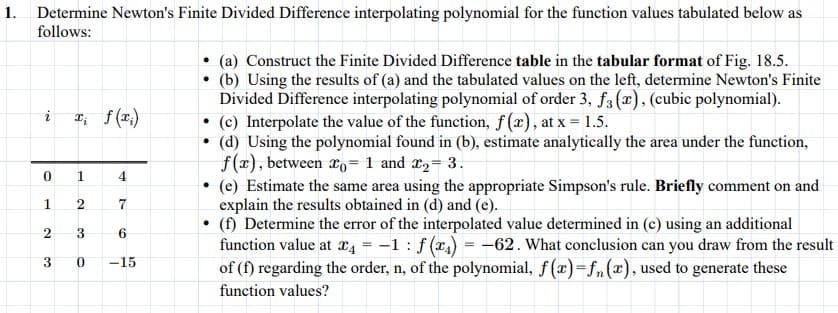Determine Newton's Finite Divided Difference interpolating polynomial for the function values tabulated below as follows: (a) Construct the Finite Divided Difference table in the tabular format of Fig. 18.5. • (b) Using the results of (a) and the tabulated values on the left, determine Newton's Finite Divided Difference interpolating polynomial of order 3, f3(x), (cubic polynomial). • (c) Interpolate the value of the function, f(x), at x = 1.5. (d) Using the polynomial found in (b), estimate analytically the area under the function, f(x), between ro = 1 and x,= 3. • (e) Estimate the same area using the appropriate Simpson's rule. Briefly comment on and explain the results obtained in (d) and (e). • (f) Determine the error of the interpolated value determined in (c) using an additional function value at x4 = -1 : f (x.) = -62. What conclusion can you draw from the result of (f) regarding the order, n, of the polynomial, f(x)=fn(x), used to generate these I; f(r.) 1 4 3 6. -15 function values? 7. 1.
Determine Newton's Finite Divided Difference interpolating polynomial for the function values tabulated below as follows: (a) Construct the Finite Divided Difference table in the tabular format of Fig. 18.5. • (b) Using the results of (a) and the tabulated values on the left, determine Newton's Finite Divided Difference interpolating polynomial of order 3, f3(x), (cubic polynomial). • (c) Interpolate the value of the function, f(x), at x = 1.5. (d) Using the polynomial found in (b), estimate analytically the area under the function, f(x), between ro = 1 and x,= 3. • (e) Estimate the same area using the appropriate Simpson's rule. Briefly comment on and explain the results obtained in (d) and (e). • (f) Determine the error of the interpolated value determined in (c) using an additional function value at x4 = -1 : f (x.) = -62. What conclusion can you draw from the result of (f) regarding the order, n, of the polynomial, f(x)=fn(x), used to generate these I; f(r.) 1 4 3 6. -15 function values? 7. 1.
Algebra & Trigonometry with Analytic Geometry
13th Edition
ISBN:9781133382119
Author:Swokowski
Publisher:Swokowski
Chapter4: Polynomial And Rational Functions
Section4.3: Zeros Of Polynomials
Problem 66E
Related questions
Question
Complete parts b through f please

Transcribed Image Text:1. Determine Newton's Finite Divided Difference interpolating polynomial for the function values tabulated below as
follows:
(a) Construct the Finite Divided Difference table in the tabular format of Fig. 18.5.
• (b) Using the results of (a) and the tabulated values on the left, determine Newton's Finite
Divided Difference interpolating polynomial of order 3, f3(x), (cubic polynomial).
• (c) Interpolate the value of the function, f(x), at x = 1.5.
• (d) Using the polynomial found in (b), estimate analytically the area under the function,
f(x), between xo=1 and x2= 3.
• (e) Estimate the same area using the appropriate Simpson's rule. Briefly comment on and
explain the results obtained in (d) and (e).
• (f) Determine the error of the interpolated value determined in (c) using an additional
function value at x4 = -1 : f (x,) = -62. What conclusion can you draw from the result
of (f) regarding the order, n, of the polynomial, f(x)=f,n (x), used to generate these
i 1, f(x.)
1
4
6.
-15
function values?
2.
Expert Solution
This question has been solved!
Explore an expertly crafted, step-by-step solution for a thorough understanding of key concepts.
This is a popular solution!
Trending now
This is a popular solution!
Step by step
Solved in 3 steps

Knowledge Booster
Learn more about
Need a deep-dive on the concept behind this application? Look no further. Learn more about this topic, advanced-math and related others by exploring similar questions and additional content below.Recommended textbooks for you

Algebra & Trigonometry with Analytic Geometry
Algebra
ISBN:
9781133382119
Author:
Swokowski
Publisher:
Cengage


Algebra & Trigonometry with Analytic Geometry
Algebra
ISBN:
9781133382119
Author:
Swokowski
Publisher:
Cengage
